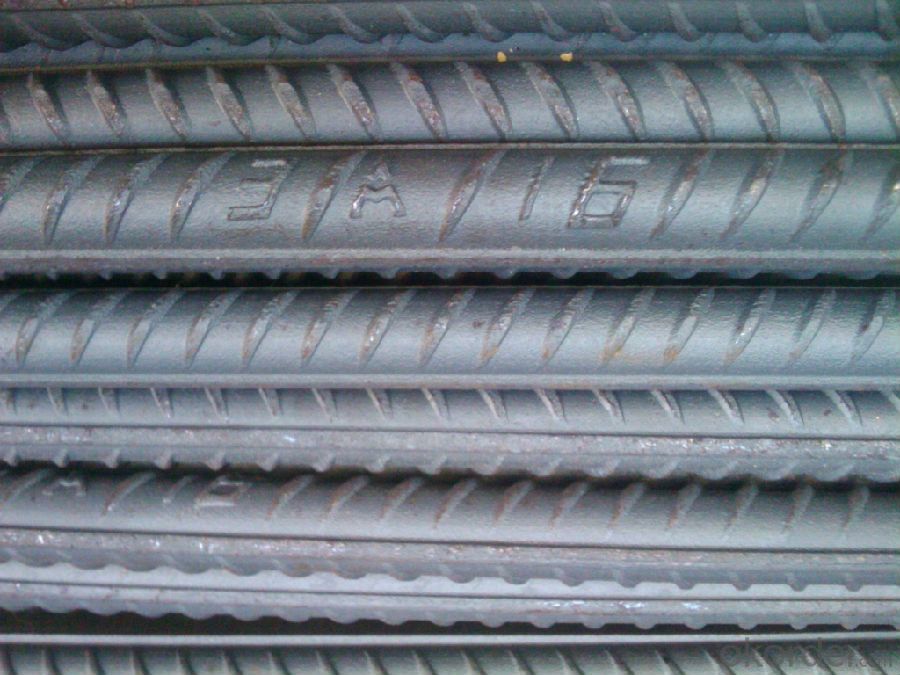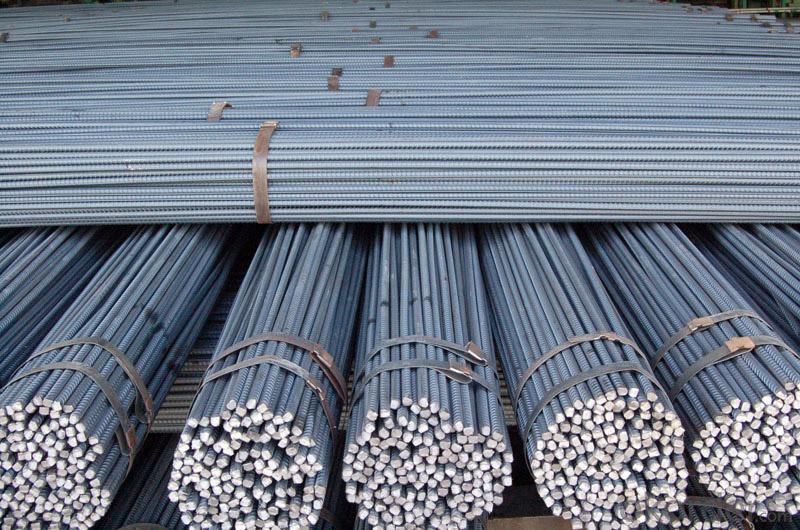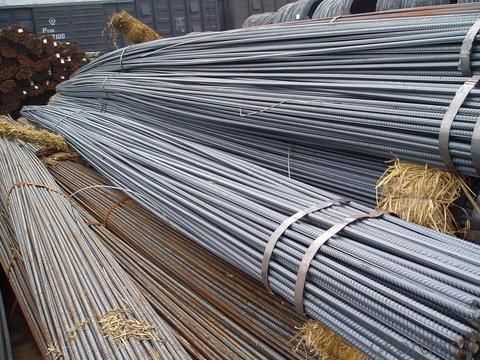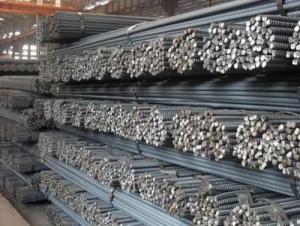8mm*50.27mm deformed steel bar deformed steel bar
- Loading Port:
- Tianjin
- Payment Terms:
- TT or LC
- Min Order Qty:
- 25 m.t.
- Supply Capability:
- 100000 m.t./month
OKorder Service Pledge
OKorder Financial Service
You Might Also Like
Product Description:
OKorder is offering 8mm*50.27mm deformed steel bar deformed steel bar at great prices with worldwide shipping. Our supplier is a world-class manufacturer of steel, with our products utilized the world over. OKorder annually supplies products to European, North American and Asian markets. We provide quotations within 24 hours of receiving an inquiry and guarantee competitive prices.
Product Applications:
8mm*50.27mm deformed steel bar are ideal for structural applications and are widely used in the construction of buildings and bridges, and the manufacturing, petrochemical, and transportation industries.
Product Advantages:
OKorder's deformed steel bar are durable, strong, and resist corrosion.
Main Product Features:
· Premium quality
· Prompt delivery & seaworthy packing (30 days after receiving deposit)
· Corrosion resistance
· Can be recycled and reused
· Mill test certification
· Professional Service
· Competitive pricing
Product Specifications:
| Minimum Order Quantity: | 25MT | Unit: | m.t. | Loading Port: | China Main Port |
| Supply Ability: | 800000 MT/YEAR | Payment Terms: | TT or LC |
Product Description:
Specifications of Deformed Steel Bar:
Standard | GB | HRB335, HRB400, HRB500 | |
UK | G460B, B500A, B500B,B500C | ||
USA | GR40, GR60 | ||
Diameter | 6mm,8mm,10mm,12mm,14mm,16mm,18mm,20mm, 22mm,25mm,28mm,32mm,36mm,40mm,50mm | ||
Length | 6M, 9M,12M or as required | ||
Place of origin | Hebei, China mainland | ||
Application | building,construction,road,bridge etc | ||
Brand name | DRAGON | ||
Theoretical weight and section area of each diameter as below for your information:
Diameter(mm) | Section area (mm²) | Mass(kg/m) |
6 | 28.27 | 0.222 |
8 | 50.27 | 0.395 |
10 | 78.54 | 0.617 |
12 | 113.1 | 0.888 |
14 | 153.9 | 1.21 |
16 | 201.1 | 1.58 |
18 | 254.5 | 2.00 |
20 | 314.2 | 2.47 |
22 | 380.1 | 2.98 |
25 | 490.9 | 3.85 |
28 | 615.8 | 4.83 |
32 | 804.2 | 6.31 |
36 | 1018 | 7.99 |
40 | 1257 | 9.87 |
50 | 1964 | 15.42 |
Usage and Applications of Deformed Steel Bar:
Deformed bar is widely used in buildings, bridges, roads and other engineering construction. Big to highways, railways, bridges, culverts, tunnels, public facilities such as flood control, dam, small to housing construction, beam, column, wall and the foundation of the plate, deformed bar is an integral structure material. With the development of world economy and the vigorous development of infrastructure construction, real estate, the demand for deformed bar will be larger and larger..
Packaging & Delivery of Deformed Steel Bar:
Packaging Detail: products are packed in bundle and then shipped by container or bulk vessel, deformed bar is usually naked strapping delivery, when storing, please pay attention to moisture proof. The performance of rust will produce adverse effect.
Each bundle weight: 2-3MT, or as required
Payment term: TT or L/C
Delivery Detail: within 45 days after received advanced payment or LC.
Label: to be specified by customer, generally, each bundle has 1-2 labels
Trade terms: FOB, CFR,
Note:
1. Our products are produced according to national standard (GB), if not, supply according to national standards (GB) or agreement as customer required.
2. Other Grade and Standard Deformed Steel Bar we can supply:
Grade: GR40/GR60, G460B/B500A/B500B/B500C,BST500S
Standard: ASTM, BS, DIN
The Minimum Order Quantity of these products is high, and need to be confirmed.
3. We can not only supply Deformed Steel Bar; if you need anything about building materials, please contact us for further information.
4. Please send us your detail specifications when inquire. We will reply to you as soon as possible. We sincerely hope we can establish a long stable business relationship.



FAQ:
Q1: Why buy Materials & Equipment from OKorder.com?
A1: All products offered byOKorder.com are carefully selected from China's most reliable manufacturing enterprises. Through its ISO certifications, OKorder.com adheres to the highest standards and a commitment to supply chain safety and customer satisfaction.
Q2: Can stainless steel rust?
A2: Stainless does not "rust" as you think of regular steel rusting with a red oxide on the surface that flakes off. If you see red rust it is probably due to some iron particles that have contaminated the surface of the stainless steel and it is these iron particles that are rusting. Look at the source of the rusting and see if you can remove it from the surface.
- Q:How are steel rebars used in the construction of oil and gas refineries?
- Steel rebars are widely used in the construction of oil and gas refineries due to their strength and durability. These rebars, which are made of high-strength steel, provide reinforcement to concrete structures and enhance their load-bearing capacity. In oil and gas refineries, steel rebars are primarily used in the construction of various reinforced concrete structures such as foundations, columns, beams, slabs, and walls. These structures are crucial for supporting heavy equipment, storage tanks, processing units, and other essential components of the refinery. Rebars are embedded within the concrete during the construction process, forming a reinforced concrete framework that can withstand high loads, seismic activity, and extreme weather conditions. The steel reinforcement enhances the tensile strength of the concrete, making it more resistant to cracking and structural failure. The use of rebars also ensures the longevity of the refinery infrastructure. Oil and gas refineries operate in harsh environments with exposure to chemicals, high temperatures, and corrosive agents. Steel rebars possess excellent resistance to corrosion, which is essential for maintaining the structural integrity of the refinery over time. Additionally, rebars facilitate the construction of complex shapes and configurations required in refinery structures. They can be bent, cut, and molded to fit specific design requirements, enabling the creation of intricate concrete structures that are essential for the refinery's functionality. Overall, steel rebars play a vital role in the construction of oil and gas refineries by providing the necessary reinforcement to concrete structures. Their strength, durability, and resistance to corrosion make them ideal for withstanding the demanding conditions found in these facilities, ensuring the safety and longevity of the refinery infrastructure.
- Q:What are the advantages of using stainless steel rebars?
- Using stainless steel rebars in construction projects offers several advantages. Firstly, these rebars have a remarkable resistance to corrosion, making them perfect for structures in harsh environments such as coastal or industrial areas. Unlike traditional carbon steel rebars, stainless steel rebars do not easily rust or corrode, ensuring the durability and longevity of the structure. Secondly, stainless steel rebars possess a higher tensile strength compared to carbon steel rebars. This means they can endure greater stress and loads without deforming or breaking, resulting in a safer and more reliable structure. Moreover, their high tensile strength allows for the utilization of smaller rebars, which saves construction costs and reduces the overall weight of the structure. Furthermore, stainless steel rebars exhibit excellent fire resistance properties. They retain their strength and integrity much better than carbon steel in the event of a fire, reducing the risk of structural collapse. This is particularly crucial in buildings with high fire safety requirements, such as hospitals, schools, and high-rise structures. Another advantage of stainless steel rebars is their low maintenance requirements. Due to their corrosion resistance, they do not need regular inspections or costly protective coatings. This saves both time and money in maintenance efforts. Lastly, stainless steel rebars are highly sustainable and environmentally friendly. They are 100% recyclable, reducing the demand for new raw materials and minimizing waste in construction projects. Additionally, the long lifespan of stainless steel rebars reduces the need for frequent replacements, further minimizing the environmental impact. To summarize, the benefits of using stainless steel rebars include excellent corrosion resistance, high tensile strength, superior fire resistance, low maintenance requirements, and sustainability. These advantages make stainless steel rebars the preferred choice for construction projects that prioritize durability, safety, and long-term value.
- Q:How to judge the quality of thread steel?
- Use material tester to measure data, then compare with national standard data.
- Q:Can steel rebars be used in structures with limited construction materials?
- Yes, steel rebars can be used in structures with limited construction materials. Steel rebars are commonly used as reinforcement in concrete structures to provide strength and stability. They can be easily transported and installed, making them suitable for construction projects in areas with limited access to construction materials. Additionally, steel rebars have high tensile strength, which enhances the durability and load-bearing capacity of structures, making them a reliable choice in resource-constrained environments.
- Q:Can steel rebars be used in offshore oil rig construction?
- Indeed, offshore oil rig construction can make use of steel rebars. These rebars are widely employed in the construction field, including the creation of offshore structures like oil rigs. By reinforcing concrete structures, steel rebars guarantee the solidity and robustness of the overall construction. In the context of offshore oil rig construction, it is customary to embed steel rebars within concrete foundations, columns, and other structural components to bolster their resistance against external forces such as wind, waves, and seismic activity. Through the incorporation of steel rebars, the durability and safety of offshore oil rigs are effectively ensured, rendering them fitting for the challenging conditions encountered in offshore environments.
- Q:Can steel rebars be used in water treatment plant construction?
- Yes, steel rebars can be used in water treatment plant construction. Steel rebars are commonly used as reinforcement in concrete structures, including those in water treatment plants. These rebars provide strength and durability to concrete structures, ensuring they can withstand the various stresses and loads imposed on them. Moreover, steel rebars are resistant to corrosion, which is essential in water treatment plants where exposure to water and chemicals is common. However, it is important to ensure that the rebars used in the construction of water treatment plants meet the required specifications and standards to ensure the longevity and integrity of the structures.
- Q:How do steel rebars resist corrosion?
- Passivation is the process by which steel rebars resist corrosion. When exposed to air and moisture, a thin layer of iron oxide is formed on the surface of the steel. This layer, commonly known as rust, acts as a protective barrier, preventing oxygen and moisture from reaching the inner layers of steel and halting further oxidation. To provide an additional layer of protection against corrosion, steel rebars are often coated with materials like epoxy or zinc. These coatings create a physical barrier, shielding the steel from the corrosive elements of the environment. Regular maintenance, which includes cleaning and applying protective coatings, can also contribute to prolonging the lifespan of steel rebars and preventing corrosion.
- Q:What is the process of removing steel rebars from concrete structures?
- The process of removing steel rebars from concrete structures typically involves several steps. First, the concrete surface around the rebar is often chipped away using pneumatic tools or jackhammers to expose the steel. Then, an oxyacetylene torch or a cutting disc is used to cut the rebar into smaller, more manageable pieces. If the rebar is embedded deep within the concrete, a core drilling machine may be used to create a hole around the rebar, allowing for easier removal. Finally, once the rebar is cut or loosened, it can be extracted using heavy machinery or manual labor, depending on the size and weight of the rebar.
- Q:What is the process of bending steel rebars into shapes other than straight bars?
- The process of bending steel rebars into shapes other than straight bars typically involves using specialized machinery, such as a rebar bending machine or a hydraulic bender. The rebars are placed in the machine, which applies force to bend them into the desired shape. The operator may follow blueprints or use templates to ensure accurate bending. This process is commonly used in construction and concrete reinforcement projects to create custom shapes that fit specific architectural or structural requirements.
- Q:What is the process of joining steel rebars together?
- The process of joining steel rebars together is commonly known as rebar splicing or rebar connection. It is a crucial step in reinforcing concrete structures to ensure structural integrity and strength. There are several methods for joining steel rebars, each with its own advantages and suitability depending on the specific requirements of the project. Here are some common techniques: 1. Lap Splicing: This is the most traditional and widely used method. It involves overlapping two rebars and tying them together using wire or steel tie bars. The length of the overlap is usually specified by engineering codes and standards. 2. Mechanical Splicing: Mechanical splicing involves using specially designed couplers or connectors to join two rebars together. These couplers are typically threaded or tapered, allowing the rebars to be screwed or wedged into the connector. Mechanical splicing provides a more reliable and efficient connection compared to lap splicing. 3. Welding: In certain cases, rebars can be joined together through welding. This method involves heating the rebars to their melting point and fusing them together using an electric arc. Welded splices are typically used for large-scale construction projects where high strength and durability are required. 4. Compression Splicing: Compression splicing utilizes compression fittings or sleeves to join rebars together. The rebars are inserted into the sleeves, and then a hydraulic press is used to compress the fitting, creating a strong connection. Compression splicing is particularly useful when dealing with rebars of different sizes or in areas with limited space for lap splicing. The selection of the appropriate method for joining steel rebars depends on factors such as the structural design, load requirements, and construction constraints. It is important to consult with structural engineers and adhere to local building codes and regulations to ensure proper and safe execution of the rebar splicing process.
1. Manufacturer Overview |
|
|---|---|
| Location | |
| Year Established | |
| Annual Output Value | |
| Main Markets | |
| Company Certifications | |
2. Manufacturer Certificates |
|
|---|---|
| a) Certification Name | |
| Range | |
| Reference | |
| Validity Period | |
3. Manufacturer Capability |
|
|---|---|
| a)Trade Capacity | |
| Nearest Port | |
| Export Percentage | |
| No.of Employees in Trade Department | |
| Language Spoken: | |
| b)Factory Information | |
| Factory Size: | |
| No. of Production Lines | |
| Contract Manufacturing | |
| Product Price Range | |
Send your message to us
8mm*50.27mm deformed steel bar deformed steel bar
- Loading Port:
- Tianjin
- Payment Terms:
- TT or LC
- Min Order Qty:
- 25 m.t.
- Supply Capability:
- 100000 m.t./month
OKorder Service Pledge
OKorder Financial Service
Similar products
New products
Hot products
Related keywords





























